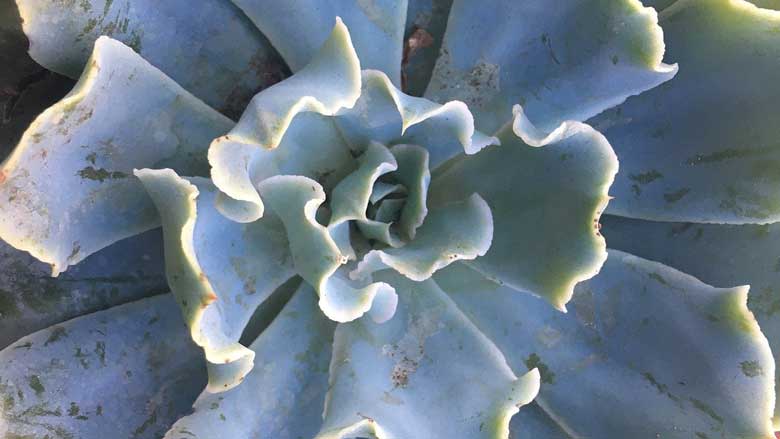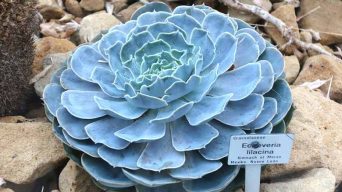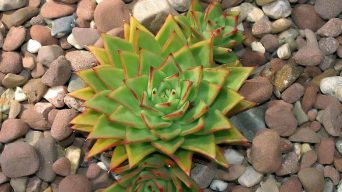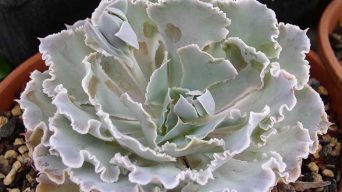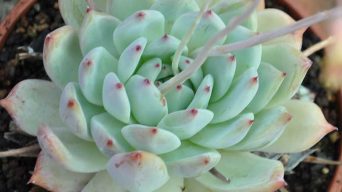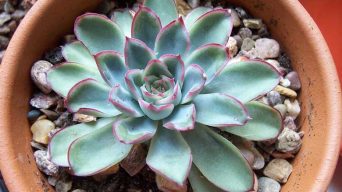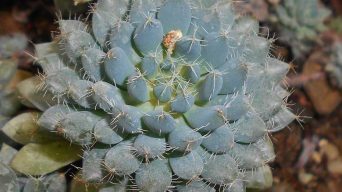Echeveria ‘Ruffles’ is a low-growing evergreen succulent variety of Echeveria that has a distinctive ruffled or wavy pattern on its leaves.
This unique look draws attention and makes the plant a real winner as a houseplant.
This is a great succulent for beginners who are just exploring the world of houseplant care, or for experienced succulent growers who want something different.
To take good care of your Echeveria ‘Ruffles’, you need to understand a few basic houseplant care concepts.
They’re really not difficult, and you’ll soon be on your way to growing healthy Echeveria ‘Ruffles’.
Overview
Echeveria ‘Ruffles’ is a flowering plant from the family Crassulaceae native to Mexico and Central America.
Echeveria ‘Ruffles’ is an evergreen succulent with large, rounded rosettes that grow up to 9-12 in. tall (22-30 cm).
The rosettes are formed by large ruffled gray-green leaves with ruffled edges that turn pink-red when exposed to full sun.
It blooms in late summer and produces tall stalks with red-orange flowers.
How To Care for Echeveria ‘Ruffles’
Echeveria ‘Ruffles’ care is straightforward and relatively easy.
These succulent plants require minimal effort to keep alive and can even thrive under less-than-ideal conditions.
You’ll find the most essential information regarding Echeveria ‘Ruffles’ care here.
Sun Exposure & Light Requirements
The best place to put your Echeveria is in an area with just 6 hours of direct sunlight daily.
If you live in a particularly hot climate, or if the temperature rises above the recommended range (too much sun), moving your plant out of the intense afternoon sun and into partial shade for its own protection may be beneficial.
When grown indoors, make sure to place your Echeveria in an area with bright, indirect sunlight.
Filtered bright light through a window works well for most succulents, but it’s best to move the plant closer to the window if you can’t get it to stay green this way.
A west-facing or east-facing window is typically your best bet, as it allows the plant to be illuminated by sunlight first thing in the morning and last thing at night.
Watering Requirements
Echeveria ‘Ruffles’ succulents are relatively drought-tolerant plants.
They should be watered thoroughly when their soil becomes dry, usually once every week or two, but they shouldn’t be watered more than twice a week because too much water can make them rot.
When watering Echeveria ‘Ruffles’, watering from underneath is important to prevent leaf or stem rot.
Echeveria ‘Ruffles’ dislikes getting water on its leaves, so using a watering can with a fine rose spout designed for seedlings is helpful.
Water should be allowed to drain freely from the bottom of the pot after watering, and the top layer of soil should be allowed to dry out between waterings.
Soil Requirements
Echeveria ‘Ruffles’ is a succulent plant and thus has different soil requirements than most other potted plants.
The most important thing for your succulents is to provide well-draining soil.
A cactus soil mix is a preferred choice for succulents and other types of cacti.
If you want to mix your own soil, a good combination would be 2 parts potting soil, 1 part coarse sand, and 1 part perlite.
Temperature and Humidity
Echeveria ‘Ruffles’ plants like temperatures to be kept on the cool side.
They prefer temperatures between 68° – 80° Fahrenheit (20 – 27°C) during the day and 50° – 70° Fahrenheit (10 – 21°C) at night.
Echeveria ‘Ruffles’ plants grow in dry environments and do not like high humidity. They will develop spots if they are subjected to high humidity.
So it is important that the environment your Echeveria Ruffles plant grows in has low humidity.
They can be grown outside year-round in many areas but should only be grown indoors if you have a cool place for them to get plenty of sunlight during the day.
Fertilizing
Echeveria ‘Ruffles’ plants don’t need to be fertilized regularly.
Just fertilize once every two months during the growing season. Use a balanced liquid fertilizer diluted to half-strength.
Sprinkle the fertilizer around the base of the plant and water well.
When you do fertilize it, be careful not to overdo it because Echeveria ‘Ruffles’ plants don’t like too much fertilizer.
Potting and Repotting
The best time for repotting is in spring when the plant’s growth begins to show.
Repotting is not a complicated process and must be done every one to two years as the plant grows.
This is because as your Echeveria ‘Ruffles’ plant gets bigger, its roots will fill the pot, and become pot-bound to the point where they are not able to absorb enough water and nutrients.
If you want to ensure that your succulent plant stays healthy and for it to grow big and strong, always repot on a pot with good drainage holes one size bigger.
After you have removed the plant from its old pot, use a fork to gently remove all the soil from around the roots until you have exposed them completely.
Remove dead or rotting roots and trim long roots to 5 or 6 inches.
Next, position the plant in its new pot and fill the bottom with soil until it is about an inch from the top of the pot.
Position your Echeveria ‘Ruffles’ so that it sits at the same depth as before. Remember that it is important not to bury the stem or crown of your plant in soil.
After repotting, don’t water the plant for a week. This will allow the new roots to grow and strengthen, making them better able to obtain water and nutrients from the soil.
Pruning
Echeveria plants don’t need to reduce the number of leaves when they grow, but if you want to have a plant with a more compact growth habit, pruning is necessary.
The best time to prune Echeveria plants is when they are in active growth, usually from early spring until late summer.
Remove any damaged or dead leaves with sharp, clean pruning shears. This helps prevent infection or infestation of pests and diseases. It also allows the plant to grow and recover more efficiently.
If you want to prune a bunch of leaves, make sure you remove them in one clean motion by snipping with your shears instead of tearing the leaves off.
This will help avoid scarring or wounding on the leaf surface that can lead to infection by pests and diseases.
Pests and Diseases
The Echeveria ‘Ruffles’ plant has few disease problems, but it has many pests that attack the leaves and stems.
The most common culprits are aphids, mealybugs, scale insects, and whiteflies.
Mealybugs
Mealybugs look like cottony masses in the plant’s crown or at its leaf joints.
They suck juices from the leaves and stems, causing a yellowing of the plant tissue.
A severe infestation can cause the death of young plants.
Scale insects
These pests also look like waxy patches on the stem but have legs that will carry them around.
They cause the plant to lose vigor and look sickly, then drop off it, leaving behind a sticky secretion that can obstruct leaf pores.
Whiteflies
These insects are the most troublesome, as they fly above plants and leave a white powder on leaves that stunts growth.
They also suck juices from leaves, causing yellowing and brown spots.
Aphids
Aphids are common, too.
They cover themselves with a white powder that makes them look like mealybugs and feed on succulent tissue, looking for tender young growth to pierce.
When they settle in a group, they may cause the plant to lose vigor and die.
How to Care for Echeveria ‘Ruffles’ in Winter
Echeveria ‘Ruffles’ plants are not cold hardy, which means they don’t like cold weather. In fact, in winter, they may need to be brought inside to a warmer room.
There are different opinions about when Echeveria ‘Ruffles’ should be brought in and taken out, but it is usually around 5-10°C (40-50°F).
This will vary depending on where you live and also the time of the year.
Echeveria ‘Ruffles’ does not like cold drafts, and, especially in wintertime, protecting them from the wind is important.
One way to protect Echeveria ‘Ruffles’ from cold drafts is by surrounding them with other robust plants to tolerate lower temperatures.
When you bring your Echeveria ‘Ruffles’ inside for wintertime, an ideal location would be a south-facing window where it receives direct light and warmth.
If you live in an area with mild winters, it is possible to grow them outside during the winter by placing them in a partially shaded location where they will still get sun and be protected from harsh winds.
This may help the plant survive the winter months so that it can bloom again next summer.
How To Propagate Echeveria ‘Ruffles’
Echeveria ‘Ruffles’ can be easily propagated from stem cuttings and leaves.
Propagating Echeveria ‘Ruffles’ from Stem Cuttings
Stem cuttings are the most common way to propagate Echeveria ‘Ruffles’.
To propagate Echeveria ‘Ruffles’ from stem cuttings:
- Cut a stem off the mother plant
- Strip the leaves off the lower half of the stem
- Place in warm, moist potting soil until roots are well established
- Transplant into an appropriate-sized container to start growing Echeveria ‘Ruffles’ plants.
Propagating Echeveria ‘Ruffles’ from Leaves
Leaves can also be propagated easily from Echeveria ‘Ruffles’ plants.
To propagate Echeveria ‘Ruffles’ from leaves:
- Remove a leaf from the stem of the mother plant.
- Let the leaf callous over for a few days.
- Place the leaf in warm, moist potting soil until the roots are well established.
- Transplant into an appropriate-sized container to start growing Echeveria ‘Ruffles’ plants.
Final Thoughts
Growing succulents like the Echeveria ‘Ruffles’ is not difficult at all, and you don’t need to be a skilled or experienced grower.
As long as you provide them with the right growing conditions and meet their basic needs, they will reward you with beautiful flowers and interesting foliage.
Just follow all of the steps from this article, and you will have beautiful Echeveria ‘Ruffles’ growing from your very own hands in no time!
To learn more about different succulent plants and how to take care of them, feel free to browse through the rest of this website. I hope you enjoyed this article and found it helpful.

